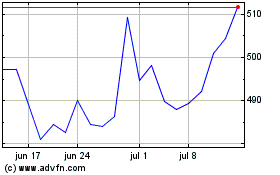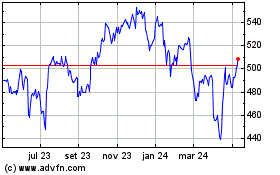Futures Pointing To Initial Strength On Wall Street
17 Abril 2024 - 10:08AM
IH Market News
The major U.S. index futures are currently pointing to a higher
open on Wednesday, with stocks likely to see initial strength
following the lackluster performance seen in the previous
session.
Traders may once again look to pick up stocks at relatively
reduced levels following recent weakness in the markets.
While the Dow managed to snap a six-day losing streak on
Tuesday, the Nasdaq and the S&P 500 closed lower for the third
straight session, falling to their lowest closing levels in almost
two months.
However, recent bargain hunting efforts have been thwarted by
ongoing concerns the Federal Reserve will hold off on cutting
interest rates until later in the year.
A lack of major U.S. economic data may also keep some traders on
the sidelines, although the Fed’s Beige Book may attract some
attention later in the day.
Stocks showed a lack of direction over the course of the trading
day on Tuesday, as traders took a breather following the sell-off
seen over the two previous sessions. The major averages bounced
back and forth across the unchanged line before eventually closing
narrowly mixed.
While the Dow rose 63.86 points or 0.2 percent to 37,798.97,
snapping a six-session losing streak, the Nasdaq edged down 19.77
points or 0.1 percent to 15,865.25 and the S&P 500 slipped
10.41 points or 0.2 percent to 5,051.41.
The modest gain by the Dow came amid a surge by shares of
UnitedHealth (NYSE:UNH), with the health insurance giant spiking by
5.2 percent.
UnitedHealth rallied after reporting first quarter results that
exceeded analyst estimates on both the top and bottom lines.
On the other hand, a 2.1 percent slump by shares of Johnson
& Johnson (JNJ) limited the upside for the blue chip index even
though the healthcare giant reported first quarter earnings that
beat expectations.
The lack of direction shown by the broader markets came as
traders weighed the idea of picking up stocks at relatively reduced
levels against concerns about the outlook for interest rates.
The yield on the benchmark ten-year note reached its highest
intraday levels in almost six months after the Federal Reserve
released a report showing a continued increase in U.S. industrial
production in the month of March.
The Fed said industrial production climbed by 0.4 percent in
March, matching the upwardly revised advance in February as well as
economist estimates.
Adding to the rate worries, Fed Chair Jerome Powell indicated in
afternoon remarks that rates are likely to remain higher for longer
amid a “lack of progress” toward reaching the central bank’s
inflation goal.
“Recent data shows solid growth and continued strength in the
labor market, but also a lack of further progress so far this year
on returning to our 2 percent inflation goal,” Powell said during a
moderated discussion with Bank of Canada Governor Tiff Macklem.
Fed officials, including Powell, have repeatedly stated they
need “greater confidence” inflation is slowing before they consider
cutting interest rates.
“The recent data have clearly not given us greater confidence,
and instead indicate that it’s likely to take longer than expected
to achieve that confidence,” Powell said. “That said, we think
policy is well positioned to handle the risks that we face.”
Banking stocks considerable weakness on the day, with the KBW
Bank Index falling by 1.6 percent to its lowest closing level in
well over a month.
Bank of America (NYSE:BAC) helped lead the sector lower,
tumbling by 3.5 percent after reporting first quarter earnings that
beat analyst estimates but decreased year-over-year.
Interest rate-sensitive utilities, telecom, housing and
commercial real estate stocks also showed significant moves to the
downside.
Gold, airline and oil service stocks also saw notable weakness,
while strength was visible among computer hardware and
semiconductor stocks.
UnitedHealth (NYSE:UNH)
Gráfico Histórico do Ativo
De Mar 2024 até Abr 2024

UnitedHealth (NYSE:UNH)
Gráfico Histórico do Ativo
De Abr 2023 até Abr 2024
